Study on the Impact of Offshore Wind Farms on Surrounding Water Environment in the Yangtze Estuary Based on Remote Sensing
Highlights
- High spatial resolution satellite data reveal the change details of SSC and Chl-a concentrations induced by windfarms.
Abstract
1. Introduction
2. Materials and Methods
2.1. Study Area
2.2. Satellite Data
2.3. Wind Field, SST, SSS, Tidal Current, and Topography Data
| Field (Units) | Data Source | Spatiotemporal Scale | Reference |
|---|---|---|---|
| MODIS-SST (°C) | MODIS Aqua monthly 4 km | 4 km/day | http://apdrc.soest.hawaii.edu/data/data.php/, accessed on 27 November 2022 |
| SSS (‰) | GLOBAL_ANALYSIS_FORECAST_PHY_001_024 | 0.083°/1 month | https://data.marine.copernicus.eu/product/GLOBAL_ANALYSISFORECAST_PHY_001_024/description, accessed on 20 November 2022 |
| 10 m wind | ERA5 monthly averaged data | 0.25°/1 month | https://www.ecmwf.int/, accessed on 27 November 2022 |
| Ocean current (m/s) | FVCOM | 1 km/1 h | [50] |
| Topography | Submarine Topography Dataset | 5′/1 | http://mds.nmdis.org.cn/, accessed on 20 November 2022 |
2.4. Data Processing
2.4.1. Data Preprocessing
2.4.2. SSC Inversion
2.4.3. Inversion of Chlorophyll-a Concentration
3. Results
3.1. SSC and Chl-aC in the Yangtze River Estuary
3.2. SSC and Chl-aC near the OWF
3.3. Wind Farm Array
4. Discussion
4.1. Wind Turbines Induce Change in Local Tidal Current
4.2. Wind Turbines Induce Change in SSC and Chl-aC
4.3. Natural Factors Influencing the Distribution of SSC and Chl-aC
4.4. Suggestions for the Self-Compensatory Effect of Wind Turbines to Reduce Sediment Loss
4.5. Strengths and Weaknesses of the Methodology
5. Conclusions
Author Contributions
Funding
Data Availability Statement
Acknowledgments
Conflicts of Interest
References
- Cui, L.; Lv, S.; Dong, Y.; Gao, X.; Li, L.; Liu, F.; Cen, J. Influence on the biological community and environmental factors around Qi’ao Island caused by reclamation project. J. Trop. Oceanogr. 2017, 36, 96–105. [Google Scholar]
- Li, M.; Li, W.; Xie, M.; Xu, T. Morphodynamic Responses to the Hong Kong–Zhuhai–Macao Bridge in the Pearl River Estuary, China. J. Coast. Res. 2020, 37, 168–178. [Google Scholar] [CrossRef]
- Jiang, S.; Hu, R.; Feng, X.; Zhu, L.; Zhang, W.; Liu, A. Influence of the construction of the Yantai West Port on the dynamic sedimentary environment. Mar. Georesour. Geotechnol. 2018, 36, 43–51. [Google Scholar] [CrossRef]
- Rodrigues, S.; Restrepo, C.; Kontos, E.; Teixeira Pinto, R.; Bauer, P. Trends of offshore wind projects. Renew. Sustain. Energy Rev. 2015, 49, 1114–1135. [Google Scholar] [CrossRef]
- Jiang, S.; Xu, N.; Li, Z.; Huang, C. Satellite derived coastal reclamation expansion in China since the 21st century. Glob. Ecol. Conserv. 2021, 30, e01797. [Google Scholar] [CrossRef]
- Lai, S.; Loke, L.H.L.; Hilton, M.J.; Bouma, T.J.; Todd, P.A. The effects of urbanisation on coastal habitats and the potential for ecological engineering: A Singapore case study. Ocean Coast. Manag. 2015, 103, 78–85. [Google Scholar] [CrossRef]
- Henry, L.A.; Harries, D.; Kingston, P.; Roberts, J.M. Historic scale and persistence of drill cuttings impacts on North Sea benthos. Mar. Environ. Res. 2017, 129, 219–228. [Google Scholar] [CrossRef]
- Paine, M.D.; DeBlois, E.M.; Kilgour, B.W.; Tracy, E.; Pocklington, P.; Crowley, R.D.; Williams, U.P.; Gregory Janes, G. Effects of the Terra Nova offshore oil development on benthic macro-invertebrates over 10 years of development drilling on the Grand Banks of Newfoundland, Canada. Deep Sea Res. Part II Top. Stud. Oceanogr. 2014, 110, 38–64. [Google Scholar] [CrossRef]
- Perkins, M.J.; Ng, T.P.T.; Dudgeon, D.; Bonebrake, T.C.; Leung, K.M.Y. Conserving intertidal habitats: What is the potential of ecological engineering to mitigate impacts of coastal structures? Estuar. Coast. Shelf Sci. 2015, 167, 504–515. [Google Scholar] [CrossRef]
- Ni, Y.-L.; Wu, L.-C.; Xu, J.; Zhang, Y. The impact of submarine cable laying on the surrounding marine environment in Lvhua Island. Energy Rep. 2022, 8, 262–270. [Google Scholar] [CrossRef]
- Liu, X.; Liu, J.; Feng, X. Study on the marine sedimentary environment evolution of the southern Laizhou Bay under the impact of port projects. J. Ocean Univ. China 2016, 15, 553–560. [Google Scholar] [CrossRef]
- Lv, T.; Sun, B.; Wang, J.; Jin, Y.; He, X.; Yu, H.; Ma, Y. The hydrodynamic environment variability of Laizhou bay response to the marine engineering. Mar. Environ. Sci. 2017, 36, 571–577. [Google Scholar] [CrossRef]
- Li, X.; Niu, F.; Wang, L.; Li, J.; Cui, J.; Sun, X. Simulation study on the impact of future large-scale reclamation projects on tidal hydrodynamic environment in the Bohai Bay. Mar. Sci. Bull. 2018, 37, 320–327. [Google Scholar] [CrossRef]
- Wang, Q.; Xu, H.; Yin, J.; Du, S.; Liu, C.; Li, J.Y. Significance of the great protection of the Yangtze River: Riverine input contributes primarily to the presence of PAHs and HMs in its estuary and the adjacent sea. Mar. Pollut. Bull. 2023, 186, 114366. [Google Scholar] [CrossRef]
- Yang, Y.; Liu, P.; Zhou, H.; Xia, L.-F. Evaluation of biodiversity variation and ecosystem health assessment in Changjiang estuary during the past 15 years. Acta Ecol. Sin. 2020, 40, 8892–8904. [Google Scholar]
- Wang, X.; Xie, P.; Li, Q.; Zhang, J.; Li, H. Ecological Environment of the Yangtze Estuary and Protection Countermeasures. Res. Environ. Sci. 2020, 33, 1197–1205. [Google Scholar] [CrossRef]
- Deng, G.; Shen, Y.; Li, C.; Tang, J. Computational investigation on hydrodynamic and sediment transport responses influenced by reclamation projects in the Meizhou Bay, China. Front. Earth Sci. 2020, 14, 493–511. [Google Scholar] [CrossRef]
- Chen, Y.; Gao, J. Numerical Simulation of Suspended Sediment from the Typical Engineering in the Dafeng River. J. Guangxi Acad. Sci. 2022, 38, 420–428. [Google Scholar] [CrossRef]
- Zhang, Y.; Zhang, W.; Chi, W.; Bian, S.; Cao, C.; Hu, Z.; Liu, J. Numerical simulation of sedimentation and siltation before and after Jiaozhou Bay Bridge construction. J. Appl. Oceanogr. 2020, 39, 368–377. [Google Scholar] [CrossRef]
- Huang, S.; Liu, J.; Cai, L.; Zhou, M.; Bu, J.; Xu, J. Satellites HY-1C and Landsat 8 Combined to Observe the Influence of Bridge on Sea Surface Temperature and Suspended Sediment Concentration in Hangzhou Bay, China. Water 2020, 12, 2595. [Google Scholar] [CrossRef]
- Bu, J. Spatial-Temporal Variation of Chl-a and SSC in Coastal Waters of China Based on GF-4 and HY-1C Satellites. Master’s Thesis, Zhejiang Ocean University, Zhoushan, China, 2022. [Google Scholar]
- Wang, J.; Liu, Y.; Li, M.; Yang, K.; Cheng, L. Drilling platform detection based on ENVISAT ASAR remote sensing data:A case of southeastern Vietnam offshore area. Geogr. Res. 2013, 32, 2143–2152. [Google Scholar] [CrossRef]
- Wang, Y.; Li, L. Remote sensing monitoring for the oil and gas platform in the South China Sea. Geol. Surv. China 2021, 8, 58–63. [Google Scholar] [CrossRef]
- Hasager, C.B.; Vincent, P.; Badger, J.; Badger, M. Using Satellite SAR to Characterize the Wind Flow around Offshore Wind Farms. Energies 2015, 8, 5413–5439. [Google Scholar] [CrossRef]
- Lu, Z.; Li, G.; Liu, Z.; Wang, L. Offshore wind farms changed the spatial distribution of chlorophyll-a on the sea surface. Front. Mar. Sci. 2022, 9, 1008005. [Google Scholar] [CrossRef]
- Zhang, Y.; Sun, Y.; Wang, E.; Zhang, W.; Hu, Z. Numerical simulation of hydrodynamic influence in the Changle offshore wind farm. Coast. Eng. 2019, 38, 294–304. [Google Scholar] [CrossRef]
- Wang, W.; Chen, X.; Zhang, H.; He, Q.; Yang, J. The Analysis of the Effect of Offshore Wind Farm Project in the Laizhou Bay on the Local Tidal Current Field. Bull. Sci. Technol. 2017, 33, 57–61+76. [Google Scholar] [CrossRef]
- Siedersleben, S.K.; Lundquist, J.K.; Platis, A.; Bange, J.; Bärfuss, K.; Lampert, A.; Cañadillas, B. Micrometeorological impacts of offshore wind farms as seen in observations and simulations. Environ. Res. Lett. 2018, 13, 124012. [Google Scholar] [CrossRef]
- Zhan, X.; Ma, L.; Lu, Z. Review on the effect of offshore wind farms on macrobenthos. Chin. J. Ecol. 2021, 40, 586–592. [Google Scholar] [CrossRef]
- Song, C.; Hou, J.-L.; Zhao, F.; Zhang, T.-T.; Wang, S.-K.; Zhuang, P. Macrobenthos community structure and its relationship with environmental factors in the offshore wind farm of the East China Sea Bridge in spring and autumn. Mar. Fish. 2017, 39, 21–29. [Google Scholar] [CrossRef]
- Wilber, D.H.; Brown, L.; Griffin, M.; DeCelles, G.R.; Carey, D.A.; Pol, M. Demersal fish and invertebrate catches relative to construction and operation of North America’s first offshore wind farm. ICES J. Mar. Sci. 2022, 79, 1274–1288. [Google Scholar] [CrossRef]
- Coates, D.A.; Deschutter, Y.; Vincx, M.; Vanaverbeke, J. Enrichment and shifts in macrobenthic assemblages in an offshore wind farm area in the Belgian part of the North Sea. Mar. Environ. Res. 2014, 95, 1–12. [Google Scholar] [CrossRef] [PubMed]
- Pollock, C.J.; Lane, J.V.; Buckingham, L.; Garthe, S.; Jeavons, R.; Furness, R.W.; Hamer, K.C. Risks to different populations and age classes of gannets from impacts of offshore wind farms in the southern North Sea. Mar. Environ. Res. 2021, 171, 105457. [Google Scholar] [CrossRef] [PubMed]
- Song, C.; Hu, L.; Zhao, F.; Zhang, T.; Yang, G.; Geng, Z.; Zhuang, P. Fish community structure and its relationship with environmental factors in offshore wind farm waters of the Yangtze Estuary. J. Fish. Sci. China 2022, 29, 469–482. [Google Scholar]
- Lin, Z. Discussion on the influence of offshore wind farm construction on fishery production and the countermeasures in Fujian Province. J. Fish. Res. 2016, 38, 415–418. [Google Scholar] [CrossRef]
- Sun, Y.; Jiang, X.; Qin, S.; Chen, S.; Luo, Y.; Shan, L.; Guo, J. Current situation and prospect of integrated development of offshore wind power and marine ranching. Aquaculture 2022, 43, 70–73. [Google Scholar] [CrossRef]
- Yang, H.; Ru, X.; Zhang, L.; Lin, C. Industrial Convergence of Marine Ranching and Offshore Wind Power: Concept and Prospect. J. Chin. Acad. Sci. 2019, 34, 700–707. [Google Scholar] [CrossRef]
- Chen, H.; Sun, X.; Zhang, C.; Feng, L. Feasibility analysis on the integrated development of marine ranch and offshore wind power in Guangdong Province. Mar. Sci. Bull. 2022, 41, 208–214. [Google Scholar] [CrossRef]
- Guan, Y.; Wang, S.; Wen, D. Processes of runoff and sediment load in the source regions of the Yangtze River. J. Sediment Res. 2021, 46, 43–49+56. [Google Scholar] [CrossRef]
- Zeng, D.; Xuan, J.; Huang, D.; Zhou, F.; Zhang, T.; Ni, X. Study on tide and tidal current near the Changjiang (Yangtze River) Estuary based on observational data. J. Mar. Sci. 2022, 40, 12–20. [Google Scholar] [CrossRef]
- Cheng, G.; Liu, Y.; Chen, Y.; Gao, W. Spatiotemporal variation and hotspots of climate change in the Yangtze River Watershed during 1958–2017. J. Geogr. Sci. 2022, 32, 141–155. [Google Scholar] [CrossRef]
- Wang, J.; Wang, J.; Xu, J.; Yang, Y.; Lyv, Y.; Luan, K. Seasonal and interannual variations of sea surface temperature and influencing factors in the Yangtze River Estuary. Reg. Stud. Mar. Sci. 2021, 45, 101827. [Google Scholar] [CrossRef]
- Niu, Y.; Zhao, X.; Zhou, Y.; Tian, B.; Wang, L. Sea Surface Salinity Spatio-Temporal Differentiation in Yangtze Estuarine Waters Using MODIS. J. Jilin Univ. 2019, 49, 1486–1495. [Google Scholar] [CrossRef]
- Shen, Y.; Chen, L.; Wang, G. Analysis on the characteristics of marine water and sediment in the area of Shanghai Lingang Offshore Wind Power Phase II Project. China Water Transp. 2020, 9, 138–140. [Google Scholar] [CrossRef]
- Li, J.; Dai, Z.; Liu, X.; Zhao, J.; Feng, L. Research on the movement of water and suspended sediment and sedimentation in Nanhuizui spit of the Yangtze Estuary before and after the construction of reclamation projects on the tidal flat. J. Sediment Res. 2010, 3, 31–37. [Google Scholar] [CrossRef]
- Liu, J.; Xin, C.; Wu, H.; Zeng, Q.; Shi, J. Potential Application of GF-6 WFV Data in Forest Typess Monitoring. Spacecr. Recovery Remote Sens. 2019, 40, 107–116. [Google Scholar] [CrossRef]
- Mou, H.; Li, H.; Zhou, Y.; Dong, R. Response of Different Band Combinations in Gaofen-6 WFV for Estimating of Regional Maize Straw Resources Based on Random Forest Classification. Sustainability 2021, 13, 4603. [Google Scholar] [CrossRef]
- Deng, Z.; Lu, Z.; Wang, G.; Wang, D.; Ding, Z.; Zhao, H.; Xu, H.; Shi, Y.; Cheng, Z.; Zhao, X. Extraction of fractional vegetation cover in arid desert area based on Chinese GF-6 satellite. Open Geosci. 2021, 13, 416–430. [Google Scholar] [CrossRef]
- Hersbach, H.; Bell, B.; Berrisford, P.; Hirahara, S.; Horányi, A.; Muñoz-Sabater, J.; Nicolas, J.; Peubey, C.; Radu, R.; Schepers, D.; et al. The ERA5 global reanalysis. Q. J. R. Meteorol. Soc. 2020, 146, 1999–2049. [Google Scholar] [CrossRef]
- Chen, C.; Beardsley, R.C.; Cowles, G. An unstructured-grid finite-volume coastal ocean model (FVCOM) system. Oceanography 2006, 19, 78–89. [Google Scholar] [CrossRef]
- Chen, C.; Xue, P.; Ding, P.; Beardsley, R.C.; Xu, Q.; Mao, X.; Gao, G.; Qi, J.; Li, C.; Lin, H.; et al. Physical mechanisms for the offshore detachment of the Changjiang Diluted Water in the East China Sea. J. Geophys. Res. Ocean. 2008, 113. [Google Scholar] [CrossRef]
- Yang, L. ENVI high-resolution remote sensing image data preprocessing. J. Jiaozuo Univ. 2020, 34, 97–100. [Google Scholar] [CrossRef]
- Zhao, J.; Li, J.; Liu, Q.; Wang, H.; Chen, C.; Xu, B.; Wu, S. Comparative Analysis of Chinese HJ-1 CCD, GF-1 WFV and ZY-3 MUX Sensor Data for Leaf Area Index Estimations for Maize. Remote Sens. 2018, 10, 68. [Google Scholar] [CrossRef]
- Kong, Z.; Yang, H.; Zheng, F.; Li, Y.; Qi, J.; Zhu, Q.; Yang, Z. Research advances in atmospheric correction of hyperspectral remote sensing images. Remote Sens. Nat. Resour. 2022, 34, 1–10. [Google Scholar] [CrossRef]
- Guo, L.; Liu, Y.; He, H.; Lin, H.; Qiu, G.; Yang, W. Consistency analysis of GF-1 and GF-6 satellite wide field view multi-spectral band reflectance. Optik 2021, 231, 166414. [Google Scholar] [CrossRef]
- Sun, W.; Chen, B.; Messinger, D. Nearest-neighbor diffusion-based pan-sharpening algorithm for spectral images. Opt. Eng. 2014, 53, 013107. [Google Scholar] [CrossRef]
- Cai, L.; Tang, D.; Levy, G.; Liu, D. Remote sensing of the impacts of construction in coastal waters on suspended particulate matter concentration—The case of the Yangtze River delta, China. Int. J. Remote Sens. 2016, 37, 2132–2147. [Google Scholar] [CrossRef]
- Cai, L.; Tang, R.; Yan, X.; Zhou, Y.; Jiang, J.; Yu, M. The spatial-temporal consistency of chlorophyll-a and fishery resources in the water of the Zhoushan archipelago revealed by high resolution remote sensing. Front. Mar. Sci. 2022, 9, 1022375. [Google Scholar] [CrossRef]
- Xiao, Y.; Liu, J.; Wu, Z.; Wen, T. Study on scouring process around bridge pier. J. Sediment Res. 2018, 43, 67–72. [Google Scholar] [CrossRef]
- Yuce, M.I.; Kareem, D.A. A Numerical Analysis of Fluid Flow around Circular and Square Cylinders. J.-Am. Water Work. Assoc. 2016, 108, E546–E554. [Google Scholar] [CrossRef]
- Qi, M.; Shi, P. Study on the mechanism of water-sediment interaction in the scouring process around a pile. Shuili Xuebao 2018, 49, 1471–1480. [Google Scholar] [CrossRef]
- Nimbalkar, P.; Rathod, P.; Manekar, V.; Bhalerao, A. Scour model for circular compound bridge pier. Water Supply 2022, 22, 5111–5125. [Google Scholar] [CrossRef]
- Khaple, S.; Hanmaiahgari, P.R.; Gaudio, R.; Dey, S. Interference of an upstream pier on local scour at downstream piers. Acta Geophys. 2017, 65, 29–46. [Google Scholar] [CrossRef]
- Pasupuleti, L.N.; Timbadiya, P.V.; Patel, P.L. Flow fields around tandem and staggered piers on a mobile bed. Int. J. Sediment Res. 2022, 37, 737–753. [Google Scholar] [CrossRef]
- Qi, H.; Zhang, C.; Xuan, W.; Tian, W.; Li, J. Effects of Span on Local Scour Depth around Four Columns of Tandem Piers in Clear Water. Iran. J. Sci. Technol. Trans. Civ. Eng. 2023, 47, 1777–1789. [Google Scholar] [CrossRef]
- Wang, H.; Tang, H.W.; Liu, Q.S.; Wang, Y. Local Scouring around Twin Bridge Piers in Open-Channel Flows. J. Hydraul. Eng. 2016, 142, 06016008. [Google Scholar] [CrossRef]
- Miozzi, M.; Corvaro, S.; Alves Pereira, F.; Brocchini, M. Wave-induced morphodynamics and sediment transport around a slender vertical cylinder. Adv. Water Resour. 2019, 129, 263–280. [Google Scholar] [CrossRef]
- Ong, M.C.; Holmedal, L.E.; Myrhaug, D. Numerical simulation of suspended particles around a circular cylinder close to a plane wall in the upper-transition flow regime. Coast. Eng. 2012, 61, 1–7. [Google Scholar] [CrossRef]
- Cai, L.; Tang, D.; Li, C. An investigation of spatial variation of suspended sediment concentration induced by a bay bridge based on Landsat TM and OLI data. Adv. Space Res. 2015, 56, 293–303. [Google Scholar] [CrossRef]
- Fu, G. Short-term morphological process of the Nanhui mudflat in the Yangtze River estuary. Port Waterw. Eng. 2018, 97–103+137. [Google Scholar] [CrossRef]
- Khosronejad, A.; Kang, S.; Sotiropoulos, F. Experimental and computational investigation of local scour around bridge piers. Adv. Water Resour. 2012, 37, 73–85. [Google Scholar] [CrossRef]
- Chen, M.; Peng, G.; Wang, H.; Xu, D.; Li, J. Experimental study on three-dimensional topography and flow structure around bridge piers under local scour. J. Hydroelectr. Eng. 2021, 40, 13–24. [Google Scholar] [CrossRef]
- Fu, G.; Li, J.; Dai, Z.; Wu, R.; Yu, Z. Study of tidal flow numerical simulation on the reclamation project of nanhuizui beach. Trans. Oceanol. Limnol. 2007, 4, 47–54. [Google Scholar] [CrossRef]
- Voet, H.E.E.; Van Colen, C.; Vanaverbeke, J. Climate change effects on the ecophysiology and ecological functioning of an offshore wind farm artificial hard substrate community. Sci. Total Environ. 2022, 810, 152194. [Google Scholar] [CrossRef] [PubMed]
- Michaelis, R.; Hass, H.C.; Mielck, F.; Papenmeier, S.; Sander, L.; Gutow, L.; Wiltshire, K.H. Epibenthic assemblages of hard-substrate habitats in the German Bight (south-eastern North Sea) described using drift videos. Cont. Shelf Res. 2019, 175, 30–41. [Google Scholar] [CrossRef]
- Liu, Y.; Hua, Y.; Zhou, H.; Ye, L.; Wang, G.; Jin, J.; Bao, Z. Precipitation variation and trend projection in the eastern monsoon region of China since 1470. Adv. Water Sci. 2022, 33, 1–14. [Google Scholar] [CrossRef]
- Yang, H.; Li, B.; Zhang, C.; Qiao, H.; Liu, Y.; Bi, J.; Zhang, Z.; Zhou, F. Recent Spatio-Temporal Variations of Suspended Sediment Concentrations in the Yangtze Estuary. Water 2020, 12, 818. [Google Scholar] [CrossRef]
- Yang, Y.-P.; Zhang, M.-J.; Li, Y.-T.; Zhang, W. The variations of suspended sediment concentration in Yangtze River Estuary. J. Hydrodyn. 2015, 27, 845–856. [Google Scholar] [CrossRef]
- Ou, S.; Yang, Q.; Luo, X.; Zhu, F.; Luo, K.; Yang, H. The influence of runoff and wind on the dispersion patterns of suspended sediment in the Zhujiang (Pearl) River Estuary based on MODIS data. Acta Oceanol. Sin. 2019, 38, 26–35. [Google Scholar] [CrossRef]
- Chen, B.; Wang, K. Suspended Sediment Transport in the Offshore Near Yangtze Estuary. J. Hydrodyn. 2008, 20, 373–381. [Google Scholar] [CrossRef]
- Mulligan, R.P.; Smith, P.C.; Tao, J.; Hill, P.S. Wind-wave and Tidally Driven Sediment Resuspension in a Macrotidal Basin. Estuaries Coasts 2019, 42, 641–654. [Google Scholar] [CrossRef]
- Tang, R.; Shen, F.; Ge, J.; Yang, S.; Gao, W. Investigating typhoon impact on SSC through hourly satellite and real-time field observations: A case study of the Yangtze Estuary. Cont. Shelf Res. 2021, 224, 104475. [Google Scholar] [CrossRef]
- Wang, L.; Zhou, Y.; Shen, F. Suspended sediment diffusion mechanisms in the Yangtze Estuary influenced by wind fields. Estuar. Coast. Shelf Sci. 2018, 200, 428–436. [Google Scholar] [CrossRef]
- Wang, Y.; Jiang, H.; Jin, J.; Zhang, X.; Lu, X.; Wang, Y. Spatial-Temporal Variations of Chlorophyll-a in the Adjacent Sea Area of the Yangtze River Estuary Influenced by Yangtze River Discharge. Int. J. Environ. Res. Public Health 2015, 12, 5420–5438. [Google Scholar] [CrossRef] [PubMed]
- Liu, H.; Huang, L.; Tan, Y.; Ke, Z.; Liu, J.; Zhao, C.; Wang, J. Seasonal variations of chlorophyll a and primary production and their influencing factors in the Pearl River Estuary. J. Trop. Oceanogr. 2017, 36, 81–91. [Google Scholar]
- Zhao, Y.; Qin, Y.; Zhang, L.; Qiao, F.; Ma, Y. Temporal and spatial distribution of red tides in the Changjiang estuary and in adjacent waters from 1989 to 2019. Mar. Sci. 2021, 45, 39–46. [Google Scholar]
- Li, P.; Yang, S.L.; Milliman, J.D.; Xu, K.H.; Qin, W.H.; Wu, C.S.; Chen, Y.P.; Shi, B.W. Spatial, Temporal, and Human-Induced Variations in Suspended Sediment Concentration in the Surface Waters of the Yangtze Estuary and Adjacent Coastal Areas. Estuaries Coasts 2012, 35, 1316–1327. [Google Scholar] [CrossRef][Green Version]
- Vanhellemont, Q.; Ruddick, K. Turbid wakes associated with offshore wind turbines observed with Landsat 8. Remote Sens. Environ. 2014, 145, 105–115. [Google Scholar] [CrossRef]
- Chang, R.; Zhu, R.; Guo, P. A Case Study of Land-Surface-Temperature Impact from Large-Scale Deployment of Wind Farms in China from Guazhou. Remote Sens. 2016, 8, 790. [Google Scholar] [CrossRef]
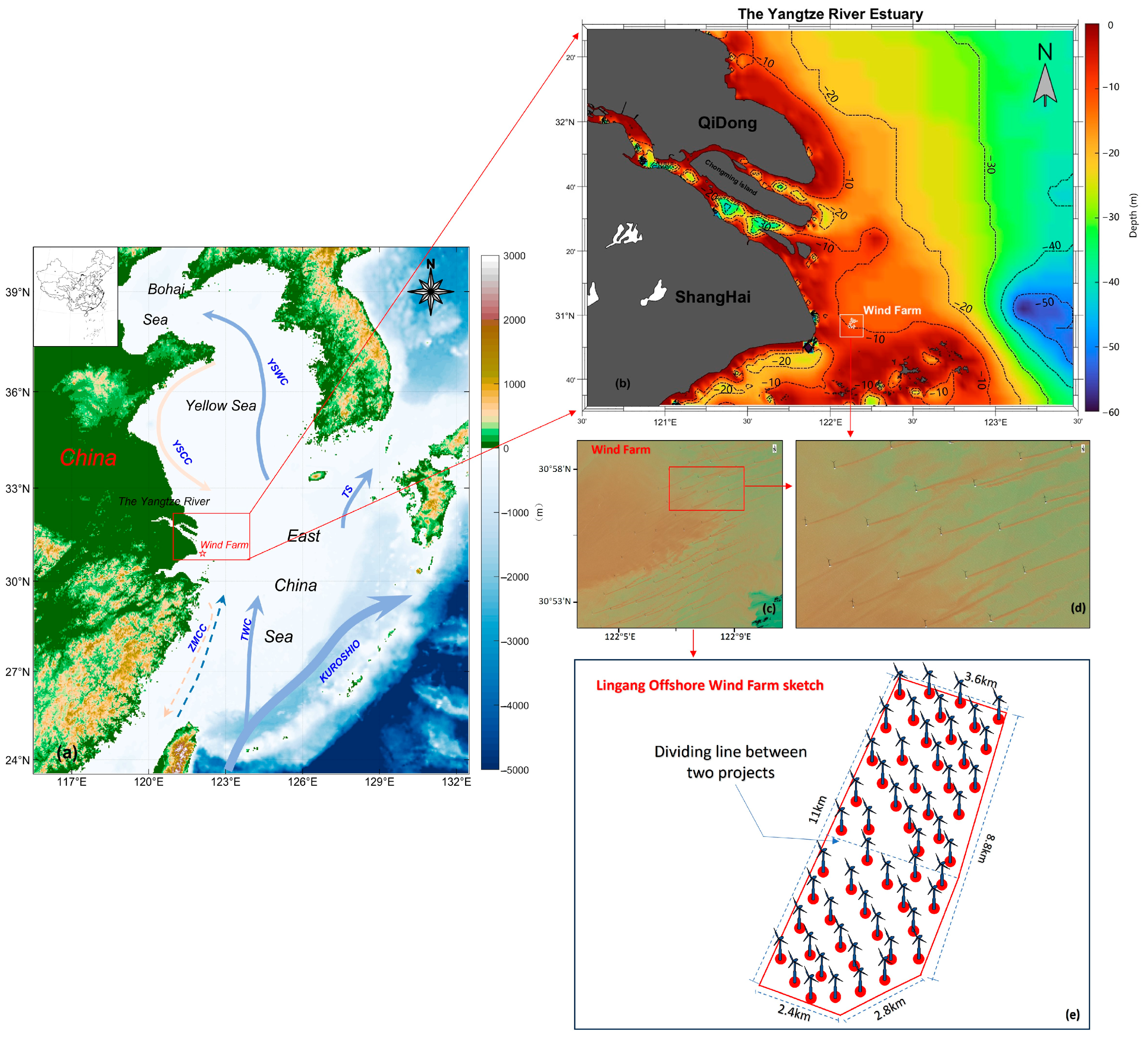
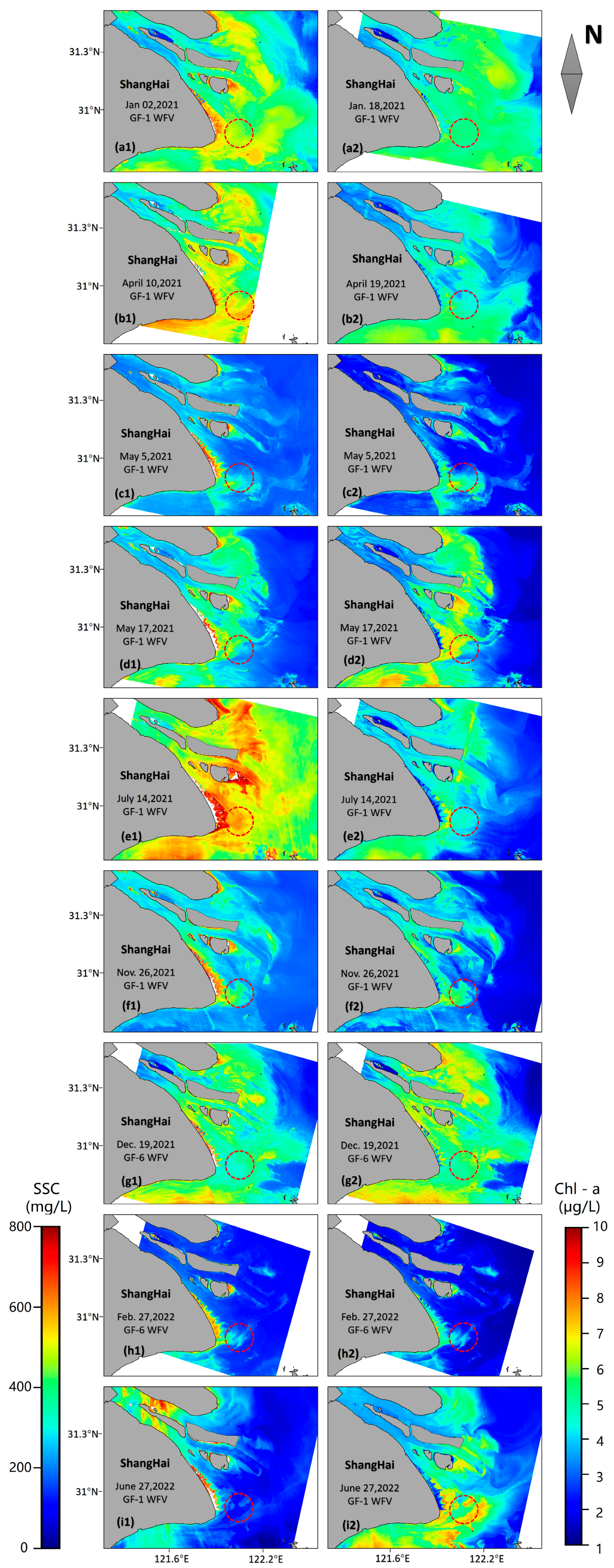


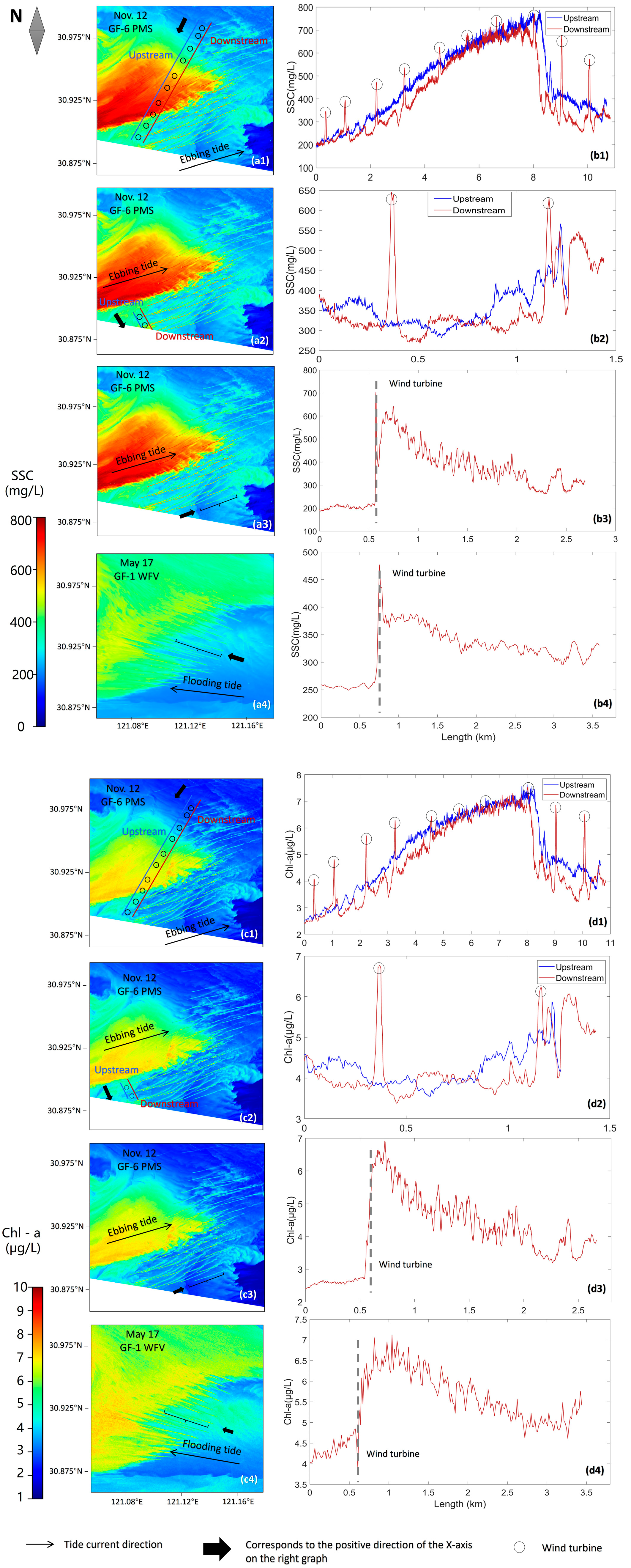
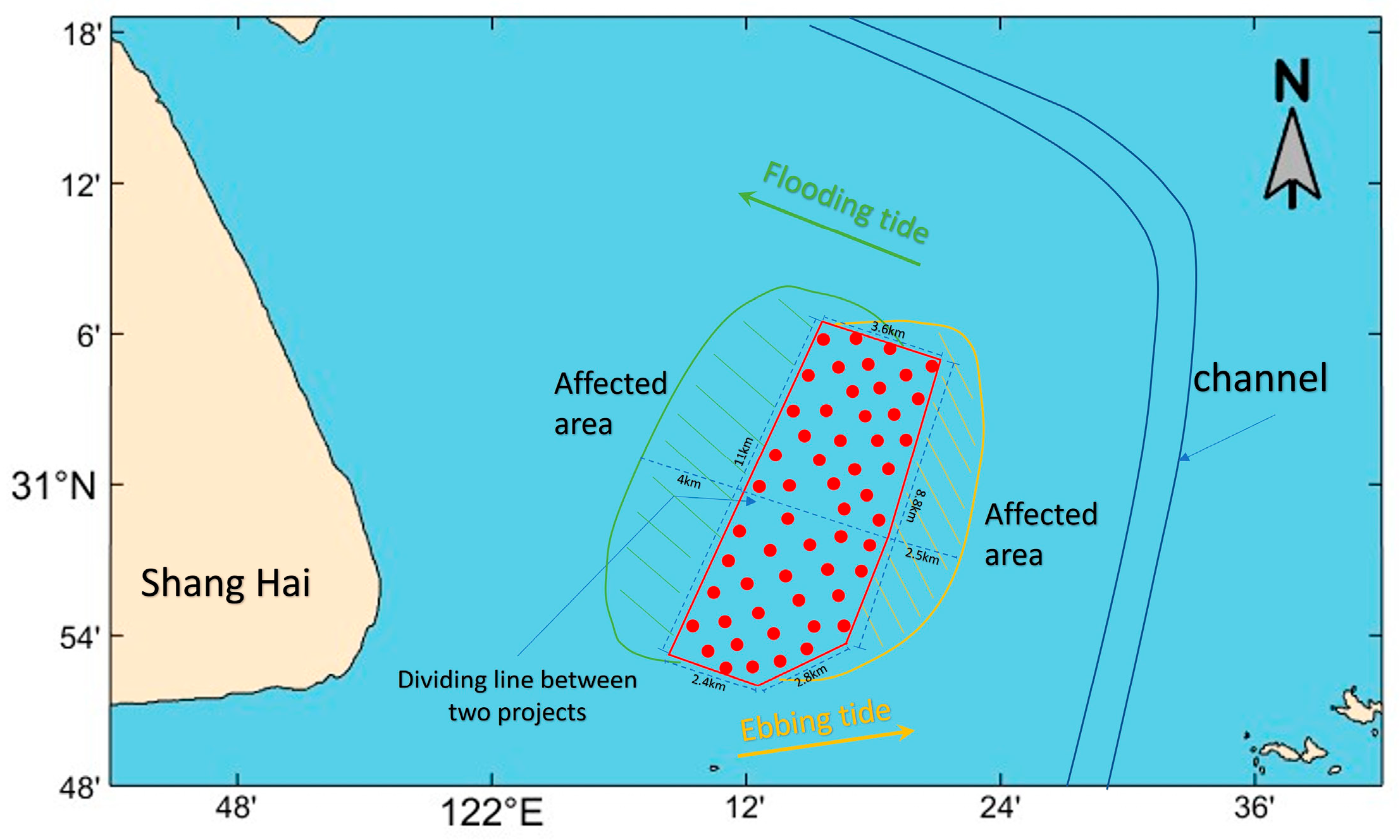
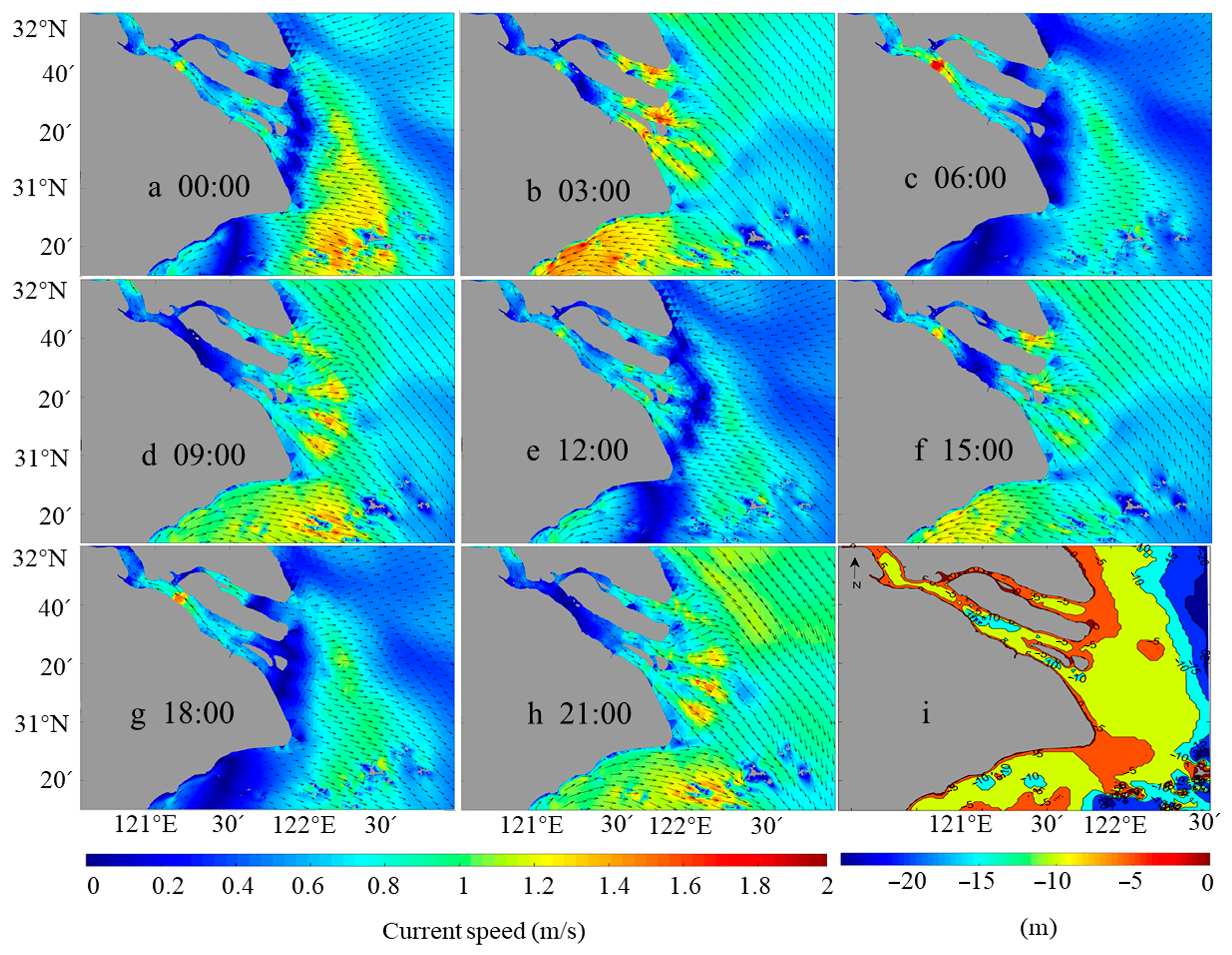
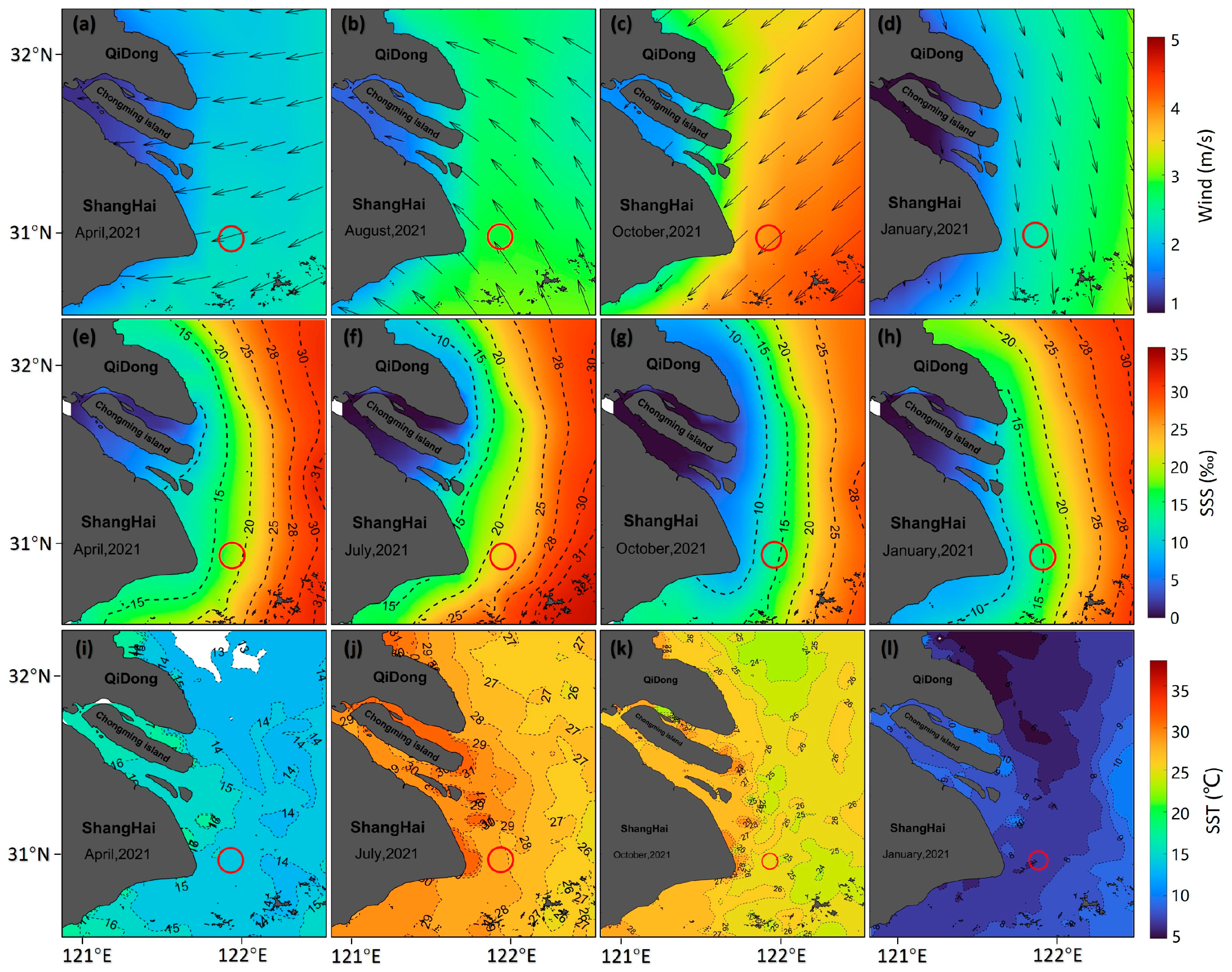
| Orbital | Sensor | Band No. | Spectral Coverage (μm) | Spatial Resolution (m) | Imagery Width (km) |
|---|---|---|---|---|---|
| Sun-synchronous orbit | GF-6 WFV | Band 1 | 0.45–0.52 | ≤16.0 | ≥800 |
| Band 2 | 0.52–0.59 | ||||
| Band 3 | 0.63–0.69 | ||||
| Band 4 | 0.77–0.89 | ||||
| Band 5 | 0.69–0.73 | ||||
| Band 6 | 0.73–0.77 | ||||
| Band 7 | 0.40–0.45 | ||||
| Band 8 | 0.59–0.63 | ||||
| Sun-synchronous orbit | GF-6 PMS | Band 1 | 0.45–0.52 | 8 | ≥90 |
| Band 2 | 0.52–0.60 | ||||
| Band 3 | 0.63–0.69 | 2 | |||
| Band 4 | 0.76–0.90 | ||||
| Band 5 | 0.45–0.90 |
| Orbital | Sensor | Band No. | Spectral Coverage (μm) | Spatial Resolution (m) | Imagery Width (km) |
|---|---|---|---|---|---|
| Sun-synchronous orbit | GF-1 WFV | Band 1 | 0.45–0.52 | 16 | 800 |
| Band 2 | 0.52–0.59 | ||||
| Band 3 | 0.63–0.69 | ||||
| Band 4 | 0.77–0.89 | ||||
| Sun-synchronous orbit | GF-1 PMS | Band 1 | 0.45–0.52 | 8 | 60 |
| Band 2 | 0.52–0.59 | ||||
| Band 3 | 0.63–0.69 | 2 | |||
| Band 4 | 0.77–0.89 | ||||
| Band 5 (PAN) | 0.45–0.90 |
| Sensor | Calibration Coefficients | PAN | Band 1 | Band 2 | Band 3 | Band 4 | Band 5 | Band 6 | Band 7 | Band 8 |
|---|---|---|---|---|---|---|---|---|---|---|
| GF-1 WFV1 | Gain | - | 0.1722 | 0.1496 | 0.1227 | 0.1308 | - | - | - | - |
| Offset | - | 0 | 0 | 0 | 0 | - | - | - | - | |
| GF-6 WFV | Gain | - | 0.0633 | 0.0532 | 0.0508 | 0.0325 | 0.0523 | 0.0463 | 0.0670 | 0.0591 |
| Offset | - | 0 | 0 | 0 | 0 | 0 | 0 | 0 | 0 | |
| GF-6 PMS | Gain | 0.0577 | 0.0821 | 0.0671 | 0.0518 | 0.0310 | - | - | - | - |
| Offset | 0 | 0 | 0 | 0 | 0 | - | - | - | - |
Disclaimer/Publisher’s Note: The statements, opinions and data contained in all publications are solely those of the individual author(s) and contributor(s) and not of MDPI and/or the editor(s). MDPI and/or the editor(s) disclaim responsibility for any injury to people or property resulting from any ideas, methods, instructions or products referred to in the content. |
© 2023 by the authors. Licensee MDPI, Basel, Switzerland. This article is an open access article distributed under the terms and conditions of the Creative Commons Attribution (CC BY) license (https://creativecommons.org/licenses/by/4.0/).
Share and Cite
Cai, L.; Hu, Q.; Qiu, Z.; Yin, J.; Zhang, Y.; Zhang, X. Study on the Impact of Offshore Wind Farms on Surrounding Water Environment in the Yangtze Estuary Based on Remote Sensing. Remote Sens. 2023, 15, 5347. https://doi.org/10.3390/rs15225347
Cai L, Hu Q, Qiu Z, Yin J, Zhang Y, Zhang X. Study on the Impact of Offshore Wind Farms on Surrounding Water Environment in the Yangtze Estuary Based on Remote Sensing. Remote Sensing. 2023; 15(22):5347. https://doi.org/10.3390/rs15225347
Chicago/Turabian StyleCai, Lina, Qunfei Hu, Zhongfeng Qiu, Jie Yin, Yuanzhi Zhang, and Xinkai Zhang. 2023. "Study on the Impact of Offshore Wind Farms on Surrounding Water Environment in the Yangtze Estuary Based on Remote Sensing" Remote Sensing 15, no. 22: 5347. https://doi.org/10.3390/rs15225347
APA StyleCai, L., Hu, Q., Qiu, Z., Yin, J., Zhang, Y., & Zhang, X. (2023). Study on the Impact of Offshore Wind Farms on Surrounding Water Environment in the Yangtze Estuary Based on Remote Sensing. Remote Sensing, 15(22), 5347. https://doi.org/10.3390/rs15225347







